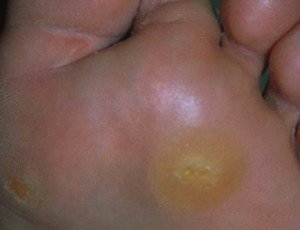Metatarsalgia
Last reviewed by Dr. Raj MD on January 12th, 2022.
What is Metatarsalgia?
This is a medical disorder that happens because of the inflammation of your nerve that runs between the metatarsals, which are the bones that can be found between the toes and ankles and is considered to be the ball of your foot.
Metatarsalgia is a general term that physician’s use to describe the pain in the area just before your toes, referred to as under-the-ball-of-the-foot. You will find this medical disorder usually located under the second, third, and fourth metatarsal heads of your foot.
Many times physician will refer to metatarsalgia as a symptom rather than a disorder. It has also been referred to as a stone bruise. This medical disorder affects women and men equally but the ones most often found to suffer from metatarsalgia are women of middle-age. It is considered a non-serious medical condition.
Symptoms
The most prominent symptom of metatarsalgia is pain in your foot but there are other symptoms such as:
- Experiencing sharp burning pain in the part of your foot that is just behind your toes.
- Having pain in the middle of your foot.
- Swelling, numbness, and a tingling sensation in your toes.
- Callusing and pain only near your big toe or around your fourth, third, or second toe.
- Experiencing sharp pain while running, standing, or walking but gets better when you are resting your foot.
- Extreme pain when you walk barefoot, especially on surfaces that are hard like ceramic tile or concrete.
- Pain when you flex your foot.
- Feeling in your foot as if you have a pebble in your shoe when you walk.
The severity of the pain varies from person to person and it can affect just one or two of your toes. It can also affect your whole foot or even both feet. It usually will get worse when you put weight is put on your foot. At times these symptoms may suddenly develop, especially if you have increased your amount of jumping, high impact exercise, or running. It can also develop slowly over time.
Causes
The one significant cause of metatarsalgia is heredity. Other causes can include:
- If you have narrow feet with a high arch or flat feet you are more apt to develop this medical disorder.
- Another cause could be certain nerve and bunion disorders.
- People who perform sports activities that are extreme, dancing, running, etc are at a high risk of developing this disorder.
- Overweight or when pregnant gaining an excessive amount of weight.
- Wearing shoes that are high-heeled or tight-fitting for a long time.
- Disorders like muscle or fracture, or rheumatoid arthritis.
- Something that might change in the way your foot would normally work and affects how your weight is distributed, putting excess pressure on your metatarsals.
- Having a hammertoe which forms when you wear shoes that are too small or wearing high heels and your toes are prevented from lying flat
- Morton’s neuroma which is a non-cancerous growth of fibrous tissue around your nerve that usually happens between your fourth and third metatarsal head.
When you have metatarsalgia the small toe nerves that are found between your metatarsal bones is caught between two of the metatarsal bones and becomes inflamed. Although there are many ways metatarsalgia can happen, it may just be one of the causes or a combination of causes.
Treatment
Before any treatment is started it is important that you have a correct diagnosis of metatarsalgia because the symptoms of this disorder are similar to other common foot problems. When you see the doctor he will exam your foot and also do an x-ray to make the right diagnosis. Once it has been diagnosed your physician will prescribe medications to help with the inflammation plus medication for the pain. This medication will not only help with the pain but also with the burning and swelling you might experience.
Another treatment method would be physical therapy to help with the swelling and pain. You can even use icepacks several times a day for twenty minutes at a time and you should also rest your foot for a few days to ensure proper healing.
In addition to treatment there are also things that you can do to prevent metatarsalgia such as:
- Wear comfortable shoes or shoes that offer some type of forefoot cushioning.
- If you have flat feet you should make sure that you are wearing the right shoes for this type of medical condition.
- High heels should no be worn on a regular basis for long periods of time.
- Reduce your weight if you are overweight plus keep your weight in line with your height to avoid exerting extra pressure on your feet.
- If you are into dance or sports you need to be careful when do them plus you should try and find a way to protect your feet from being injured.
- Try to wear insoles in your shoes that are shock absorbing
- You can also use metatarsal pads or arch supports
- Wear the right socks to help provide cushioning for your foot
If you have a severe case of metatarsalgia, your physician may suggest:
- Steroid injections to help reduce the swelling and pain
- Surgery to help reshape your metatarsal bones, straighten a hammer toe or to remove/release an affected that may be irritated or trapped.
Metatarsalgia Pictures
